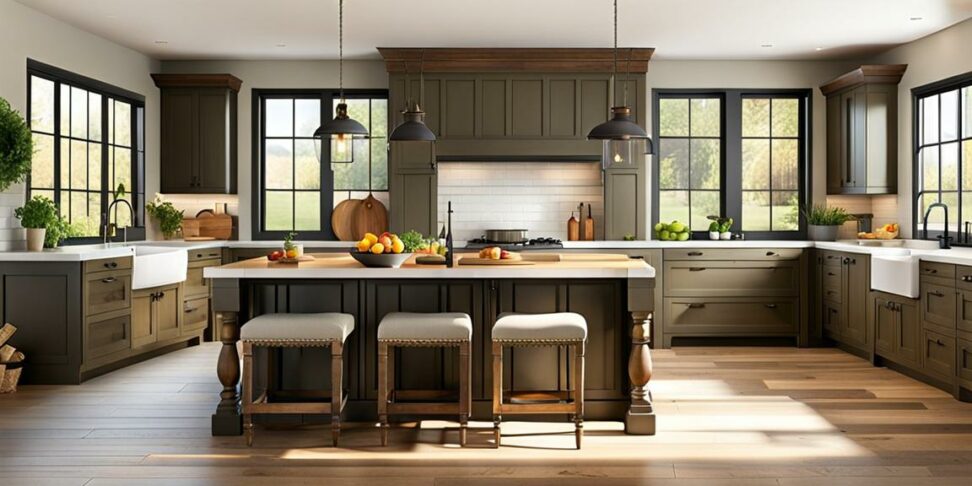Design a Cozy Farmhouse Kitchen with a Rustic Island
The farmhouse style brings warmth and vintage charm to today's kitchens. With its neutral palette, natural materials, and cozy details, this timeless look never goes out of style. The perfect farmhouse kitchen starts with an inviting, rustic island that becomes the room's anchor.
A handsome island crafted from reclaimed wood, butcher block, or patinated metal has character and versatility. Its unique shape and size can maximize prep space, add storage, and even include extras like a wine rack or breakfast bar seating. With an artful mix of finishes like whitewashing and stained wood, your rustic island achieves the ideal balance of worn and refined.
Farmhouse Style Values Simple Details and Natural Elements
The essence of farmhouse style is a pleasant contradiction - pairing elegance with simplicity. Crisp white cabinetry gets contrast from an organic, imperfect island. Delicate beadboard offers subtle texture against smooth counters. The look channels countryside cottages with vintage details for laidback charm.

This timeless aesthetic suits family kitchens. The calming, light palette feels airy but never sterile. Natural wood exudes warmth while neutral backsplashes and trim keep the look light. A touch of black iron hardware or an antique-style pendant light provides contrast without overpowering.
Wood Remains the Classic Farmhouse Island Material
For authenticity, wood islands reign supreme. Opt for reclaimed or sustainably-sourced wood to mimic the worn character of authentic farmhouse style. Tongue-and-groove planks with visible nail holes add cottage charm.
Butcher block offers an attractive contrast to white cabinetry. Opt for a wood species like maple or walnut that stains beautifully. Or keep it light with a whitewashed finish. Add vintage appeal by accenting edges with white paint antiquing.
Beyond Wood: Metals and Stone Complement Farmhouse Islands
While wood sets the farmhouse vibe, adding metal or stone elevates the look. Wrought iron legs give a handcrafted, industrial edge. Patinated tin applied to the island front and knobs provides contrast.
Marble, granite, or limestone offer an upscale, substantial surface for rolling dough and prep work. Pairing the veining and patterns with wood finishes adds natural texture and depth.
Thoughtful island shapes maximize farmhouse function
Rustic islands come in all sizes, but consider your needs before choosing shape and dimensions. Long rectangles or L-shapes maximize usable counter space. Curved fronts add softness to balance sharp cabinet edges. Customize with extras like bookshelves, a wine rack, or counter extension to seat more guests.
Maximize Your Workspace with Rectangle and L-Shaped Designs
For avid home cooks, optimize useful space with a long rectangular or L-shaped island. Allow a minimum of 36-48 inches for circulation and pull-up seating at the short end.
A rectangular island is accessible from all sides, multiplying work zones. Place the stove on an adjacent wall within view. Position the sink across from or at the end of the island to create a convenient kitchen triangle.
The L-shape maximizes prep space by using two adjoining surfaces. Make the longer side the prep zone and shorter side a casual dining spot. Floating the island parallel to cabinetry creates a spacious walkway.
Get Creative with Curves, Bookshelves, and Wine Storage
Dreaming of something beyond basic rectangle? Curved fronts add personality while softening sharp corners. Or extend only one end of the island to tuck in a bookshelf or two.
A section of wine rack storage adds function for the savvy entertainer. Or opt for open shelving to stash cookbooks and ceramics within arm's reach. Even a lowered counter section makes a perfect pull-up breakfast bar.
Whitewashing and Staining are Signature Farmhouse Island Finishes
Your island finish impacts the overall style just as much as the material. A well-done whitewashed or stained island has timeworn appeal.
Whitewashing: The Classic Farmhouse Paint Technique
Whitewashing involves painting raw wood, then intentionally distressing the finish. First, apply a milk paint, limewash, or chalk paint in white or a very pale hue. Once dry, sand areas to reveal wood tones beneath. The result is subtly weathered with charming variation.
Paint new wood planks before installation for authenticity. Focus on edges and surface indentations with sanding to mimic worn knots and nail holes. Top with a matte sealant so the finish holds up.
For islands made of reclaimed wood, a rich walnut or espresso stain looks right at home in a farmhouse kitchen. Opt for an oil-based penetrating stain to accentuate wood grain.
On new wood, choose stains in muted charcoal, gray oak, or woodland colors to mimic timeworn barn boards. Apply stain unevenly and avoid staining jammed recesses for a worn-in look.
Pair stained wood with black iron handles and pendant lights to ground the look. Whitewashed cabinetry prevents too much heaviness.